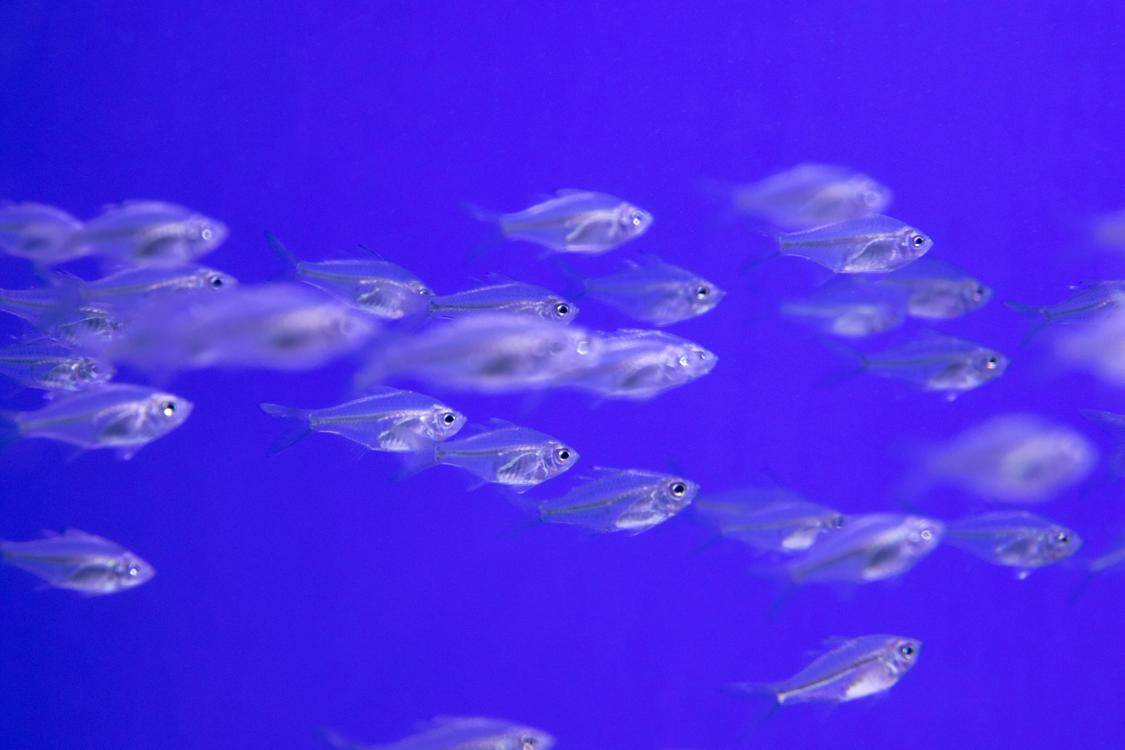About 100 million years ago, three little shrimp went house hunting. They settled in a clam—not the largest one around, but cozy nevertheless.
It’s the earliest evidence of a living creature using another’s shell for shelter, a behavior that living shrimp still exhibit today. It’s also a remarkable window into underwater biodiversity.
Alpheid Shrimps
Alpheid shrimps (also known as pistol shrimps) are a group within the infraorder Caridea and are characterized by their asymmetrical claws that produce loud snapping sounds. These sounds are used for communication, territory/burrow defense and prey catching (using rapid water jets and cavitation bubbles). The alpheids are a very diverse group, ranging from monogamous pairs to well-coordinated colonies with multiple breeding females that appear to be on the cusp of eusociality. They live in cloistered environments, most commonly sponge burrows. These environments provide a stable environment for the Alpheids and their sterile workers, as well as protection from predators. The Alpheids contribute to the stability of their host sponges, as they ingest dissolved sponge fragments and excrete waste in the form of carbon dioxide, nitrogen, and phosphorous.
Several studies have been conducted on the Alpheids, and their goby fish host, to investigate various aspects of their symbiotic relationship. These research projects have been important in developing our understanding of the complex symbiotic relationships that exist between organisms, as well as the fitness benefits and costs associated with different types of symbiosis.
The Alpheids are also interesting for their morphological diversity, considered rare shrimp. They are one of the only decapod taxa to have evolved a claw with an asymmetrical chela, with a major and minor chela. The chelae are the structural and functional basis for the snapping mechanism, allowing the Alpheids to rapidly and precisely clench objects with varying force.
In a number of fossil decapod assemblages, the distal portion of the claw fingertips are more strongly calcified than the remainder of the finger. This occurrence is consistent with the hypothesis that a strong selection pressure exists to retain and preserve these digits.
Another evocative feature of the Alpheids is their moderate orbital hoods-anterior projections of the carapace that partly or completely cover the eyes. This is unique among decapod crustaceans, and may help protect the eye from explosive claw snaps. Alpheids are thought to have evolved these hoods in the Cenozoic marine Neotropical palaeoenvironments. They may have been a keystone species that diversified the sponge-dwelling burrowing Caridean fauna of these ancient marine environments.
Alvinocaridid Shrimps
Thousands of meters below the ocean floor, hot gases and liquids erupt from cracks and chimneys on the seafloor. The hydrothermal vents emit carbon dioxide, sulfur compounds and other toxic chemicals but also provide a vital energy source to animals that make these extreme habitats their home. Despite their hostile environment, animals living around the vents must be able to sense their location and find the right chemical signals that allow them to orient themselves in the darkness of these deep-sea habitats. The vent shrimp Rimicaris exoculata is a model organism to investigate these sensory capabilities. Previous research had suggested that vent shrimp were blind, but a new study found that these creatures can see. They have a pair of eyes on their back, called the ventral fused eye, that look like large white wings and might help them locate the light-producing chemicals at the vents.
Scientists analyzed the bacterial communities in the mouthparts, foreguts and midguts of R. exoculata and two other alvinocaridid species, R. chacei from the Mid Atlantic Ridge and R. hepatopangasi from the South Woodlark Basin, and in sediment sampled from the surrounding habitat. The bacterial diversity of the digestive tract was determined by amplicon sequencing targeting the 16S rRNA gene and a genomic marker that distinguishes bacteria from archaea and fungi. The results showed that the bacterial community structure of the gut differed between wild-type shrimp incubated in sediment and those incubated without sediment. The bacterial communities in the shrimp’s digestive tract were characterized by a variety of functional traits, including carbohydrate metabolism, lipid production and degradation, nitrogen metabolic pathways and sulfur metabolism.
The results suggest that the specialized diet of these alvinocaridids may be supported by the diversity of their gut microbiota. Different stable isotopic ratios of the digestive system of these shrimp were also observed in different hydrothermal vent fields, suggesting that a certain degree of habitat fidelity exists for these shrimp species. This observation is strengthened by the fact that the d34S value of R. exoculata was more similar to those of R. chacei from the same habitat than it was in samples of shrimp from different hydrothermal vent fields, indicating that these two species share the same food sources.
Atya Shrimps

The Vampire Fan Shrimp (Atya gabonensis), also known as the African Fan shrimp or the Fan-Feeder, is a freshwater crustacean that has gained popularity in the aquarium hobby. These nocturnal shrimp are peaceful and make excellent tank mates, especially for small fish or other invertebrates. In the wild this species is found across West Africa, although it was not common as a pet until recently. Other members of this genus, including the Moluccan Fan Shrimp (Atyopsis molukkensis) and the Dwarf Fan Shrimp (Atoyida pilipes), are less common as well, but are still available from some aquarists. The new species Australatya obscura is only just entering the trade as well, but it seems to be quickly becoming the shrimp of choice among fans.
These crustaceans are characterized by the presence of long, plumose setae (Figures 2A and B) on their chelae, which they use to sweep and scrape rock or organic-matter surfaces, capturing fine particles. The chelipeds also have a set of denticles on the tips that allow them to pierce plant and other hard substrates. These specialized appendages enable the shrimp to graze on algae and other plant debris, as well as to feed from sandy or silty bottoms.
Atyids are a relatively ancient group, with evidence of widespread phylogenetical speciation dating back to the Eocene. However, they are also known to have experienced a number of recent divergences within the Caribbean, and these differences are thought to reflect both ancient Caribbean radiations and recent marine dispersals.
Molecular data suggest that the smallest-egg species (presumably ED) have the lowest intraspecific genetic divergence and broadest geographic distributions, while those with the largest eggs (presumably DA) have the highest levels of divergence and narrower distributions. This supports the hypothesis that different genera in the family Atyidae have evolved varying strategies for generating and dispersing their offspring.
These freshwater shrimps are relatively easy to care for, and should be housed in a tank of about 150 L. They are best kept with a variety of small and peaceful tankmates, such as dwarf gouramis, otocinclus, tetras, blennies and other characins, but should be avoided by large pufferfish, large aggressive botiid loaches and most cichlids.
Atyopsis Shrimps
The bamboo shrimp (Atyopsis moluccensis) is an interesting and surprisingly hardy tropical decapod with a very distinctive appearance. Their large, graceful hand fans give them their name, and they are often a striking feature in any aquarium.
These shrimp are rheophiles, meaning they thrive in fresh and fast-flowing water. They are a bit smaller than other members of the genus, reaching up to 3 inches in length. Their body color is typically light brown, but can range from shades of yellow to reddish-brown, with a lighter thoracic stripe.
The males and females of the bamboo shrimp are fairly easy to distinguish, as their forelegs are larger than the other two pairs and are usually covered in small spikes. This helps them to grip onto the substrate when feeding, a very useful trait for this type of shrimp in a fast-flowing habitat.
Another great way to tell male and female bamboo shrimp apart is by their rostrum, which is slightly more prominent in the males. Also, the first pereiopod of the male is usually longer and has a more pointed dactylus than in the females.
For anyone interested in keeping a group of bamboo shrimp, they require an aquarium of at least 20 gallons. Their specialized feeding habits mean that they can starve quickly if not given enough space to explore and find their food sources.
While the bamboo shrimp can be found in many pet stores, it is best to acquire them from a breeder that has experience raising them, especially if you are planning to keep them long-term. The breeders will have the proper conditions for these delicate creatures, including a specific temperature and nutrient levels.
While this species is considered to be of Least Concern by the IUCN, it is important to note that its population is in decline due to pollution and human development. This is a beautiful and fascinating little shrimp that can be enjoyed in many aquaria, but it is important to make sure that this species is being cared for properly. If not, the bamboo shrimp could soon be in danger of being lost from the world’s oceans.





